Menus
- Discovery
- Contact
- In the city
- Highway
- Departmental
- Comfort
- Consumption
- Braking
- Night lighting
- Convenient
- Conclusion
A 4-day trial over 1,100 km
The Triumph Tiger had taken a sacred
look of old over the years, especially compared to the new Varadero
and VStrom, despite two slight facelifts in 1999 and 2001.
It must be said that its initial presentation dated from 1993! This is
therefore a real revolution when the latter
was presented at Intermot in 2006.
The new Tiger is based on the new 1050 cc mill and
the frame already used by the Speed Triple, but
with 17 inch wheels. She suffered in passing a
slimming treatment (-17 kilos on the scale) and goes under the bar
200 kilos with its 198 kilos, while offering 106 horses to
9.400 rpm.
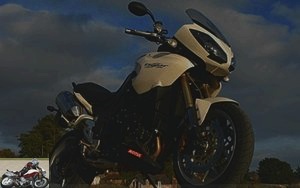
Discovery
The Tiger has taken on the appearance of a shark, with its snout elongated
and its double lenticular optic. He gained in finesse and
elegance, but kept a high waist with a
saddle at 840 mm, despite a loss of height of 10 mm. Yes
high moreover, that the pilot of 1.70 m does not touch feet to
Earth. We must therefore accept to have only a foothold and the
buttock out, with a game of balance to engage the first.
Even the 1.80 pilot does not touch both feet on the ground!
Suddenly, you have to throw the leg to go up: small sizes to abstain.
The full tank is then felt the time to pass the motorcycle
from its inclined crutch to the vertical position.
The counter takes the counter present on the Speed Triple with
an on-board computer, in the form of a digital display for information
and analog for the tachometer. Everything is there and even more: gauge
precise gasoline, totalizer, partial double trip, consumption
instantaneous, maximum speed, hour, engine temperature…
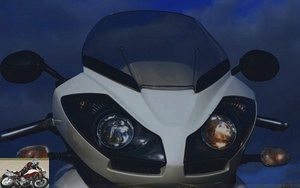
Contact
The 3 legs snort with its characteristic turbine noise.
First, the weight is instantly forgotten, and the Tiger
automatically seems lighter than its competitors to
identical displacement. Second, third, the engine takes
its turns from 2,000 rpm.
The large reservoir slightly opens the legs.
The close handlebars offer a tight rider / saddle / handlebar triangle. the
everything offers a natural driving position that is revealed
ideal for use. The handling is greatly facilitated
and allows you to forget the weight from the first few centimeters
wheels.
The mirrors, set well apart, offer a good field
of vision.
Even if the couple is present, the Tiger is much more
quieter than the Speed Triple and goes up more smoothly in the laps. The driving
is more rolled up, even if the revs
are frank.

In the city
The Tiger is very manoeuvrable and sneaks around without
difficulty between cars, easily tilting from
the first roundabouts. It also offers a short turning radius
which is very practical. In a nutshell, she turns
all alone !
The only difficulty lies in its saddle height which
makes stopping tricky for the average rider.
On the other hand, this same saddle height offers a position and a
elevated view, with a look above the traffic.
The engine accepts all speeds, including winding at
50 km / h below 2,000 rpm in 6th gear. And even under the
2,000 rpm, the Tiger is ready to pounce without snorting.
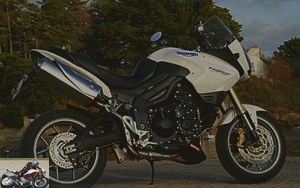
Highway
The Tiger leaps off the highway and can stall at
a slow pace of 130 km / h at 6,000 rpm. The bubble protects
very effectively up to 160-170 km / h and allows
even this speed as a "comfortable" cruising speed
(on German motorway). It then only turns at 7500 rpm.
But with a stroke of the right handle, she climbs briskly
above 200 km / h and is still only at 9,000 rpm, i.e. at
1,000 rpm from the red zone.
Even at this speed, the Tiger offers exemplary heading hold.,
without any particular turbulence, both in a straight line and in large
curves, allowing safe overtaking.

Departmental
The three-legged once again shows all its qualities with
unmatched flexibility from the lowest revs
and a big potato at the top. Even though the Tiger is capable
to wind quietly around 3,000 rpm, it quickly encourages
to turn the handle to attack in the virolos. And
the cycle part being exemplary, it is possible to have otherwise
sporty and in any case aggressive driving. Its handling is
then exemplary, without any bad surprises.
The pickups are straightforward, whatever the engine speed.
And while the Tiger doesn’t have the explosive side of a
Speed Triple, its engine encourages attack, especially since
the flawless cycle part.
She readily accepts changes of angle, and fits perfectly
in the trajectory desired by the pilot, without surprise and with ease
disconcerting. Suddenly, she gladly encourages you to turn
the handle for even more sensations.
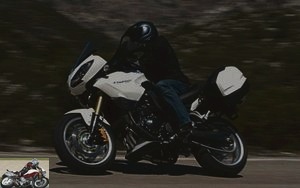
Comfort
The Tiger offers a wide saddle, even a very wide one, as well
for the pilot than for the passenger. The firm saddle reveals itself
ideal for driving that can be almost sporty on
small roads. The suspensions are well suited,
perfectly erasing road imperfections. There where
some motorcycles kick with the racket or pull up all
information from the road, the Tiger rolls on velvet.
In short, it literally swallows the defects of the road.
An asset that makes it ideal for the duo.
The handles are well placed like the toe clips.
All this makes it possible to carry out a "one-stop" trip without any problem.
deals "500 km with just a gasoline break halfway.

Consumption
The fuel gauge is precise, with its 10 sticks;
each stick fading around every 30 km.
The Tiger runs on reserve between 180 and 220 km, depending on the
rhythm. It then has a range of about sixty kilometers,
indicated precisely and decrementally
by the on-board computer. The yellow reserve indicator lights up
AND whatever the mode displayed, the Tiger switches to "number mode
of remaining kilometers "before the pump.,
with only 20 km of remaining autonomy announced, it is possible
add only 15 liters, out of the possible 20 liters of the tank.
The speaker would therefore tend to underestimate the remaining autonomy
and to leave a little more room.
The consumption varied during the test between 5.6 liters / 100 and
6.7 liters per hundred.
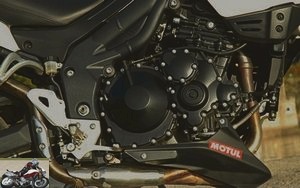
Braking
Nissin brake base is identical to that of the Speed Triple,
in much softer. The rear brake is soft, even spongy,
but at least safe in the wet. The front brake is soft
in its first third then very powerful; mass transfer
can then be important in the event of heavy braking.
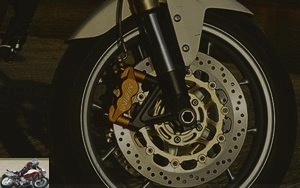
Night lighting
The meter block is particularly easy to read at night. The
headlights illuminate suitably and provide full headlight illumination
effective.
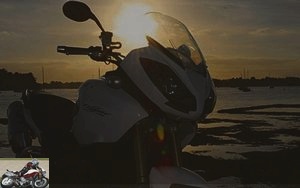
Convenient
The storage under the saddle is reduced to a space for the
block disk or rain pants.
The tank is metallic and therefore allows you to affix a
bag without problem. However, be careful with the width where
the saddlebag may interfere with the steering.
The high exit pot prohibits flexible saddlebags. It is therefore necessary to opt
for optional hard side cases.
Note the possibility of two optional saddle heights:
820mm and 860mm for very large jigs.
Conclusion
The Tiger seduces first by its face, inimitable, even
forgetting its white color. She finishes completing her operation
seductive with its engine, torquey, available, smoothly,
which is a day-to-day treat, and whatever the road.
Only its saddle height can put off, and especially for the little ones
templates making a lot of town (and therefore from foot to
Earth). You should not hesitate to take the saddle then
low 820 mm, allowing to gain 20 mm on the original saddle.
At € 10,990, the Tiger is at the same price level as the
Varadero and only 1000 more than a DL 1000, but much cheaper
only models like the KTM 950 or the XB12STT.
Strong points
- motor
- versatility
- comfort
- driving position
Weak points
- seat height
- practical aspects
- rear brake
Competitors: Buell XB 12 STT, Honda Varadero, KTM 950 Supermoto, Suzuki
DL 1000 VStrom
Datasheet
Related articles
-
Triumph Daytona 675 motorcycle test
After several sports trials 4 cylinders in 600 cm3 (TT 600 then Daytona 600), Triumph gives up to reveal finally a sports 600 based on a 3 cylinder: the…
-
A Tiger in your daily life Sporty trail, the Triumph Tiger Sport evolves with efficiency through improved mechanics and electronics and increased…
-
Triumph Street Triple 765 RS motorcycle test
The Moto2 roadster 3-cylinder engine, 765 cc, 123 HP, 79 Nm, 166 kg dry, € 11,900 Since its release in 2007, the Street Triple has been a real commercial…
-
Triumph Street Triple 675 R motorcycle test
Pocket hooligan… Appeared in 2007, the little Speed quickly gained unanimity around its engine and chassis. With 2,538 units sold in France in 2010…
-
Test carried out during a Track ‘N’ Test day on the Bresse circuit. The KTM RC8 is the first sports car of the Austrian brand, unveiled in 2003 with 990…
-
Triumph Speed Triple 955i motorcycle test
Warning ! Nasty roadster ! Is it necessary to present the Speed Triple? Jewel of the English brand, the big three legs roadster is present in all the…
-
Honda Transalp 700 XLV motorcycle test
10 day trial The Transalp is the legendary Honda 600 trail created in 1987. After several years without major modification except a displacement…
-
Triumph Tiger 955 motorcycle test
In order to respond present in all categories, Triumph presented in 1993 a big road trail, XXL version: the Tiger. Powered by a 3-cylinder 885 cc…
-
Triumph Daytona 600 motorcycle test
The wild stallion With the commercial failure of his 600 TT (and yet it was an excellent GT-Sport cf. test) and its first sporty 4-cylinder, Triumph has…
-
Suzuki DL 650 VStrom motorcycle test
Small GT with a big heart The DL 650 is the little sister of the DL 1000: a V-shaped twin cylinder with 90 ° of 650 cm3. Born a year after her big sister…